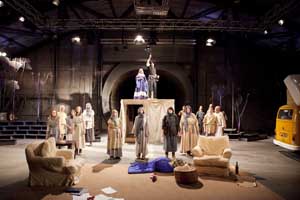Under the radar
From aircraft hangers to potting sheds, Eastern Angles has toured to all sorts of unexpected, rural venues. Ivan Cutting tracks the company’s long road to success

Touring is in the DNA of Eastern Angles. Even when we come to rest in one place there is a sense of the itinerant traveller about our set up – everything is designed to be lifted up and put somewhere else at the drop of a hat. Over the last thirty years we have toured to many non-traditional theatre spaces. Fire stations, warehouses, historic tithe barns and wind-battered marquees, and this summer we will return to one of our favourite and most spectacular spaces: a huge aircraft hangar on a former airbase.
We started Eastern Angles with two main ambitions. Firstly, to produce shows with a regional flavour; to create work with local audiences in mind, addressing, exploring and celebrating the collective experience of an area that rarely makes it on to the stage or into the media. And secondly, to take that work to its audience and stretch our constituency across an area almost the size of Wales, encompassing many different areas from coastal to agricultural, breckland to broad, bleak fenland to cosy village.
When we started out in 1982 it quickly became apparent that a catholic approach was required. Restricting ourselves to local themes could become parochial and concentrating on village hall touring took us under the radar; out of the view of funders, councillors, reviewers and some theatregoers. I sometimes compared our work to that of the SAS.
Our initial solution was to up our profile by hiring halls in significant market towns, setting up our own box office and mailing lists, attracting previews in local papers, and generally boosting our regional presence.
In the meantime we had also acquired our own small theatre in Ipswich, seating 120 in traverse. We put on an alternative Christmas panto (for kids over 16) and encouraged audiences to come to us. This cemented our box-office development, strengthened the link between our autumn and spring tours and encouraged further audiences onto our database.
So far so good, although this approach demanded a larger investment in marketing. We hired a dedicated marketing officer and developed a computerised box office system, which is more than most touring companies can justify. We sold more seats, however on tour the more seats you sell the lousier the experience for the last people to arrive – they are stuck at the back. We couldn’t exploit our success.
We started to look at raked seating options. The plan? Take over a space for a few weeks and make audiences travel to us; or arrive ‘en caravanserai’ for three-day residencies in community centres and town halls.
First we tried the extended stay. With our show The Wuffings we pitched-up at Notcutts Warehouse, the largest potting shed in Europe, and borrowed the RSC’s mobile seating rig. It was a fantastic success but we only survived by the skin of our teeth. Our box office system, created from a £75 Amstrad software pack, creaked and groaned and our two-line telephone system overheated. But we packed in 8,000 people over three weeks. It was 1997 and event culture had arrived.
With Lottery grants for a new Databox ticketing system, 300 mobile seats, a truck and support from the New Audiences programme, we tried the residency option. But this also posed problems: only school halls could offer us three nights in succession, and they either wanted work that was on the curriculum or smelt of school dinners. We either had to change our programme or think again.
We re-thought and opted for extended stays in atmospheric locations that really chimed with the shows. Tithe barns offer excellent opportunities for traverse staging, whilst simultaneously dwarfing our own theatre space and keeping people close to the drama. Marquees offer the flexibility to site shows in appropriate locations: the Sutton Hoo burial site for our play about the discovery of the Sutton Hoo treasure; a dockside for We Didn’t Mean To Go To Sea; and a war museum for our current production, Private Resistance, about the Auxiliary Units in World War II.
This summer we will return to the airbase for a thirtieth birthday production. The Hush House, where the Americans tested their jet engines, has proved quite a discovery. It has the acoustics of an intimate recording studio and the scale of an aircraft hanger. It was a perfect venue for our 2010 production Bentwater Roads, which we commissioned from Tony Ramsay especially for the space and which incorporated a community chorus. We plan to perform in this and other unexpected places for many years to come.
Join the Discussion
You must be logged in to post a comment.